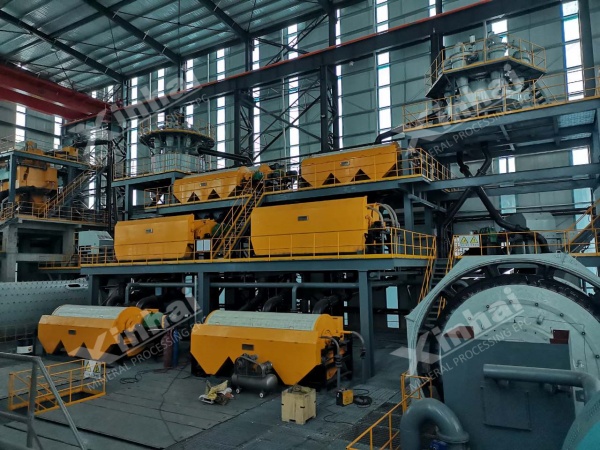If you want to know more information (such as product/process price, etc.), please contact us 24-hour telephone
Magnesite is a vital raw material used in the production of refractory materials, metallic magnesium, and environmentally friendly construction materials. However, with the continuous depletion of mineral resources, the grade of magnesite ore has been declining year by year, while the complexity of its beneficiation has been increasing. At the same time, increasingly stringent environmental regulations have led to a significant rise in the cost of traditional mining.
How can magnesite mining and mineral processing methods be scientifically and rationally planned under these conditions? This article provides a detailed overview.
Before magnesite mining begins, geological exploration must be conducted to determine the ore body’s shape, grade, and reserves. Drilling and geophysical methods are commonly used during this phase.
Mine planning involves selecting appropriate mining methods, designing mineral processing flows, and implementing environmental protection measures.

Open-pit mining: Suitable for ore bodies that are shallow, have a thin overburden, and are distributed over a large area. Its advantages include low cost and high efficiency.
Underground mining: Applied to deeply buried ore bodies and areas with complex topography. Common underground mining methods include the room-and-pillar method and sublevel caving. This method generally has higher safety requirements.
Combined mining: Involves using open-pit mining for shallow deposits and underground mining for deeper ones. This approach helps optimize resource recovery.
The mined magnesite ore is first subjected to crushing and screening. Typically, a two-stage or three-stage crushing and screening process is employed. A jaw crusher is used for primary (coarse) crushing, and a cone crusher is used for secondary (medium) crushing. The crushed ore is then fed into a vibrating screen. Particles with qualified size proceed to the grinding stage, while oversized particles are returned for further crushing.

The crushed ore enters the grinding stage, where it is ground by a ball mill. Usually, a two-stage or three-stage grinding and classification process is adopted. A grate-type ball mill is used for rough grinding, and an overflow-type ball mill is used for fine grinding. In the classification stage, hydrocyclones or spiral classifiers are selected based on the particle size distribution. During grinding, the magnesite is typically ground to 60% passing -200 mesh to achieve monomer dissociation.
Flotation is the primary method used for magnesite beneficiation.
Direct (positive) flotation: Magnesite is directly floated. Sodium sulfide (Na₂S) or sodium oleate (NaOL) is used to activate the surface of magnesite, and fatty acid collectors (such as oxidized paraffin soap) are applied to float magnesite. The froth product is magnesite concentrate.
Reverse flotation: The pulp pH is adjusted to 8–10, and water glass (sodium silicate) is added to depress silicate minerals. Cationic amine collectors (such as dodecylamine) are used to float quartz and other silicates. The froth product contains gangue minerals, while the magnesite concentrate remains in the cell.
Concentration: Coarse concentrate is re-floated to further increase the MgO content to over 95%.
Scavenging: Residual magnesite in the tailings is recovered to improve the overall recovery rate.

Magnetic separation is mainly employed to remove iron-bearing impurities from magnesite, such as limonite and magnetite.
Low-intensity magnetic separation (LIMS): Uses permanent magnetic drum separators to remove strongly magnetic minerals like magnetite.
High-intensity magnetic separation (HIMS): Utilizes high-gradient magnetic separators to eliminate weakly magnetic minerals such as limonite and hematite.
Since it is difficult to remove all impurities using a single beneficiation method, a combined process is more commonly used. Typical gangue minerals in magnesite include quartz, talc, and iron-bearing minerals.
A common combined process involves desilication via flotation, followed by magnetic separation to remove iron impurities, resulting in high-purity magnesite concentrate.
After separation, the magnesite concentrate enters the thickening and dewatering stage. A combination of high-efficiency thickener and filter press is typically used to reduce the moisture content of the filter cake to approximately 15%–20%.
If the concentrate is to be directly calcined or transported over long distances, further drying is required to reduce the moisture content to below 5%. This can be achieved using rotary dryers or belt dryers.
Tailings typically contain residual flotation reagents and high moisture content. A neutralization and precipitation process is used to remove residual reagents, followed by mechanical dewatering using equipment such as filter presses and dewatering screens to reduce moisture content before final discharge.

Magnesite projects typically have long investment payback periods, as it often takes considerable time from mine development to concentrate production. The Xinhai EPCM+O model is a turnkey service that integrates ore mining, mineral processing testwork, flowsheet design, equipment manufacturing and installation, commissioning, and plant operation. This model can reduce the overall construction period by up to 20% while helping control capital expenditures.
The Xinhai EPCM+O model covers not only early-stage equipment installation and commissioning, but also ongoing plant operation. During operation, the beneficiation process and reagent dosing systems are continuously optimized based on actual plant conditions to ensure compliance with production standards and timelines.

An intelligent monitoring system is implemented during plant operation to provide real-time emissions alerts and continuous monitoring of tailings, wastewater, and other discharges. This ensures environmental compliance and effectively mitigates ecological risks.
The Xinhai EPCM+O model features intelligent and energy-efficient mineral processing equipment and a digital mining management system to stabilize concentrate grade, reduce processing costs, and shorten project timelines.
Conclusion
With rich experience in magnesite beneficiation and a mature service model, Xinhai provides customized EPCM services and intelligent O&M (operation and maintenance), supported by in-house developed flotation and crushing equipment. Our solutions help increase MgO recovery rates to over 90% and reduce overall operating costs by up to 30%.